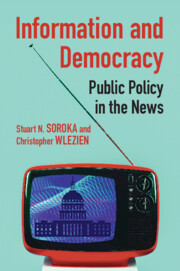Book contents
- Information and Democracy
- Communication, Society and Politics
- Information and Democracy
- Copyright page
- Contents
- Figures
- Tables
- Preface
- 1 Media in Representative Democracy
- 2 Public Responsiveness to Media
- 3 Measuring the “Media Signal”
- 4 Alternative Measures of the Media Policy Signal
- 5 The Accuracy of Media Coverage
- 6 Policy, the Media, and the Public
- 7 Diagnosing and Exploring Dynamics
- 8 Policy and the Media
- References
- Index
- Other Books in the Series (continued from page iii)
6 - Policy, the Media, and the Public
Published online by Cambridge University Press: 20 January 2022
- Information and Democracy
- Communication, Society and Politics
- Information and Democracy
- Copyright page
- Contents
- Figures
- Tables
- Preface
- 1 Media in Representative Democracy
- 2 Public Responsiveness to Media
- 3 Measuring the “Media Signal”
- 4 Alternative Measures of the Media Policy Signal
- 5 The Accuracy of Media Coverage
- 6 Policy, the Media, and the Public
- 7 Diagnosing and Exploring Dynamics
- 8 Policy and the Media
- References
- Index
- Other Books in the Series (continued from page iii)
Summary
Does media coverage matter for the functioning of representative democracy? Do people notice news coverage? Do they take it into account? In particular, do citizens use the information that media content conveys to update their policy preferences? These questions are the central motivation for this book. In this chapter we try to provide some answers. We begin by introducing our principal measures of public preferences from the General Social Survey. We then consider a smaller, unique body of data on public perceptions of policy change, from the American National Election Studies. These data allow us some preliminary insight into whether the public notices government spending and media coverage of government spending. The remainder of the chapter then presents results of analyses of public preferences, first to establish the effects of spending on preferences, and then to assess the role of the media signal. Results document thermostatic public responsiveness, as found in previous research, and also that news coverage is a critical mediating force.
Keywords
- Type
- Chapter
- Information
- Information and DemocracyPublic Policy in the News, pp. 111 - 141Publisher: Cambridge University PressPrint publication year: 2022

